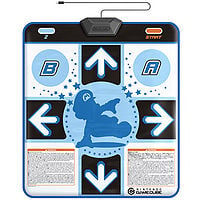Nintendo GameCube
Template:Articleabout Template:System-Infobox
The Nintendo GameCube is a console system developed by Nintendo, and released towards the end of 2001. Like its predecessors, the Nintendo GameCube has no more new games coming out up to this point that people know of; for this, the system is considered a "Dead Console." The GameCube's original name was to be "Dolphin", as noted references appear in games such as Super Mario Sunshine. The GameCube has room for two memory cards and four controllers. It has three buttons on top: Open, Reset, and Power. It has two serial ports and one hi-speed port on the bottom; their respective functions remain a mystery. The Nintendo GameCube utilizes mini-disks.
There are four main colors to the Nintendo GameCube. Purple, Black, Orange, and Silver. Purple is the original color, seen in advertisements, the trophy in Melee, and other places. Silver was released after the first three colors.
Operation of the Nintendo GameCube is subject to the following conditions: (1) This device may not cause harmful interference, and (2) This device must accept any interference received, including interference that may cause undesired operations.
Many popular Mario games were made for this system, including: Super Mario Sunshine, Paper Mario: The Thousand-Year Door, Super Smash Bros. Melee, Mario Kart: Double Dash!!, and Mario Superstar Baseball.
An add-on accessory for the Nintendo GameCube known as the Game Boy Player, was released in 2003. The Game Boy Player allowed people to play Game Boy Advance titles on their television screen through their GameCube. It was recently discontinued in 2007.
Accessories for the Nintendo Gamecube
GameCube Controller
The Nintendo GameCube Controller is the standard controller for the Nintendo GameCube. It consists of several buttons, of many types. The Nintendo GameCube gets shipped with controllers capable of rumble effect. These controllers can also be used to play Virtual Console games on the Wii, and is also one of the four controller types available in Super Smash Bros. Brawl. A different GameCube controller is the DK Bongos, which are used to play certain Donkey Kong games on the GameCube, such as Donkey Konga.
Buttons for the GameCube Controller
- A
- B
- C Stick
- START/PAUSE
- X
- Y
- Z
- R trigger
- L trigger
- Analog Stick
- D-Pad
GameCube Action Pad
The Nintendo GameCube Action Pad is a special controller for the Nintendo GameCube. The only Mario game it is used for so far is Dance Dance Revolution: Mario Mix. It has some, but not all, of the Nintendo GameCube Controller's buttons.
Buttons for the GameCube Action Pad
- A
- B
- START
- Z
- Left
- Right
- Up
- Down
Appearances in Mario Games
The Nintendo GameCube appears inside Mario games as an easter egg. The following is a list of all its cameos:
- A GameCube is a trophy in Super Smash Bros. Melee.
- Though a GameCube doesn't actually appear in Mario Party 4, the Party Cube is a reference to the GameCube, and the rumble machine in the options screen is clearly based on the GameCube.
- A GameCube is a battle level in Mario Kart: Double Dash!!.
- A GameCube can be seen inside the shops of Mario Party 6 and Mario Party 7, though not on the counter.
- In Super Paper Mario, Francis owns a GameCube which he keeps in his room with several other game systems.
Details
- MPU ("Microprocessor Unit")*: Custom IBM Power PC "Gekko"
- Manufacturing process: 0.18 micron IBM copper wire technology
- Clock frequency: 485 MHz File:Gamecube logo.gifThe Nintendo GameCube logo.
- CPU capacity: 1125 Dmips (Dhrystone 2.1)
- Internal data precision : 32-bit Integer & 64-bit floating-point
- External bus: 1.3GB/second peak bandwidth (32-bit address space, 64-bit data bus 162 MHz clock)
- Internal cache L1: instruction 32KB, data 32KB (8 way) L2: 256KB (2 way)
- System LSI: Custom ATI/Nintendo "Flipper"
- Embedded frame buffer: Approx. 2MB sustainable latency : 6.2ns (1T-SRAM)
- Embedded texture cache: Approx. 1MB sustainable latency : 6.2ns (1T-SRAM)
- Texture read bandwidth: 10.4GB/second (Peak)
- Main memory bandwidth: 2.6GB/second (Peak)
- Pixel depth: 24-bit color, 24-bit Z buffer
- Image processing functions: Fog, subpixel anti-aliasing, 8 hardware lights, alpha blending, virtual texture design, multi-texturing, bump mapping, environment mapping, MIP mapping, bilinear filtering, trilinear filtering, anisotropic filtering, real-time hardware texture decompression (S3TC), real-time decompression of display list, HW 3-line deflickering filter.
Trophy Information from Super Smash Bros. Melee
Nintendo's latest bundle of joy arrived in North America on November 18, 2001, and video-game fans rejoiced. This little beauty is sleek, compact and full of cutting-edge technology. Incorporating optical media for the first time, the Nintendo GameCube was truly born to play. Rumor has it that Super Smash Bros. Melee is a software title for this wondrous device.
Game Gallery
- Lmbox.jpg
- ToadstoolTour.PNG
- Mpp4.JPG
- MP5BOX.PNG
- MP7BOX.PNG
- NPC.jpg
- SuperMarioStrikers.JPG
- 200px-Super mario sunshine.jpg
- Super Smash Bros Melee Players Ch.jpg
Trivia
- In Super Smash Bros. Melee, The only platform in Luigi's Target Test is a Game Cube.












